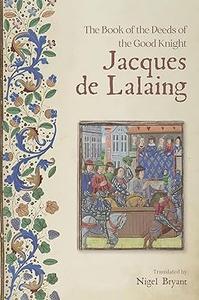
Free Download The Book of the Deeds of the Good Knight Jacques de Lalaing
by Nigel Bryant
English | 2024 | ISBN: 1783276517 | 247 Pages | True PDF | 3.46 MB
Contains detailed, eyewitness accounts of the most memorable exploits of Jacques de Lalaing, and leaves little reason to doubt that he was fit to be memorialised as a model of ideal knighthood.
'My honoured lord, I am sending you certain recollections of the high and admirable deeds of arms performed in the lists by your late son Jacques de Lalaing... But they are small memories in relation to the greatness of his deeds.'
So begins a letter that Lefèvre de Saint-Remy, 'King of Arms' of one of the grandest orders of chivalry, the Burgundian Order of the Golden Fleece, wrote to Jacques's father following the young knight's dramatic death. It contains detailed, eyewitness accounts of many of his most memorable exploits, and leaves little reason to doubt that Jacques de Lalaing was a genuinely exceptional knight, fit to be memorialised as a model of ideal knighthood.
This letter is just one of several components of the fascinating Book of the Deeds of the Good Knight Jacques de Lalaing. Not a biography by a single hand but a herald's compilation of existing documents - Lefèvre's letter, the records of other heralds and a previously lost section of Lefèvre's fine chronicle - the book traces Lalaing's career in absorbing detail.
It is a remarkable story. After serving in the Burgundian conquest of Luxembourg, Lalaing set out across Europe, challenging and jousting wherever he went from Portugal to Scotland. Most famous of all was his elaborately staged deed of arms called the Fountain of Tears. Here, on a river island in Burgundy, he stood and fought all comers for an entire year in 1449-50. With grim irony Lalaing, as glamorous in his time as any sporting hero of today, was then killed by an unglamorous cannon ball in the Ghent War of 1453.
Compiled largely from the work of heralds whose prime concern was accuracy, this book holds rich seams of information to be mined, offering invaluable insights into the behaviour and thinking of the nobility in the late Middle Ages.
The Book of the Deeds of Jacques de Lalaing follows Nigel Bryant's previous translations of chivalric biographies from earlier centuries - those of William Marshal, Bertrand du Guesclin and Geoffroi de Charny. It shows that the ideals of chivalry - including even a commitment to crusade - were still very much alive even as the nature of warfare changed, and Jacques was a complete model of those ideals, a model which remained real, attainable and absolutely relevant.
